For about a decade, artist and educator Alan Singer has been experimenting with mathematical visualization programs to make fine art. He writes computer code that recreates the natural phenomena of form and color, creating geometry-based abstractions that become dazzling monotype prints, which in turn inform the geometric visuals he paints in oil and acrylic. Singer's recent paintings and prints are featured in "Shapely," a solo exhibit currently on view at AXOM Gallery.
Singer was born into an artistic family. His father was the late wildlife artist Arthur Singer, who exposed his son to a world of artists and gallery exhibitions at a young age. And though Alan Singer's early work followed a more traditional path, he says he's always felt an impulse to push into uncharted territories.
A professor of art at Rochester Institute of Technology for 30 years, Singer points to his students' use of digital tools as one catalyst of his current mode of making art. He says he became interested in the mathematic processes behind the images created by users of such programs as Photoshop or Illustrator. And Singer was working with geometric shapes in his paintings, and says he wanted to make those shapes more perfect.
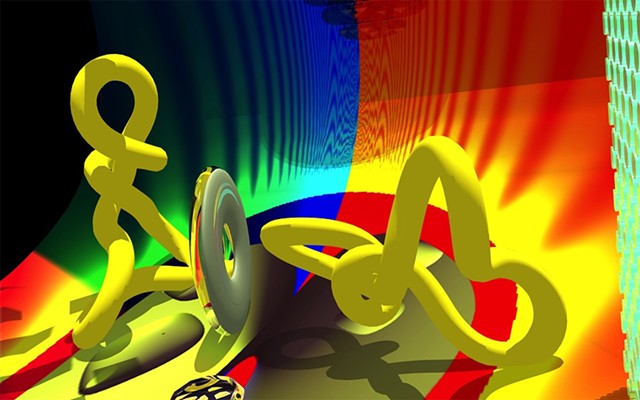
- PHOTO PROVIDED
- Alan Singer's monotype "Pose Please."
He began using mathematical visualization software such as Cinderella, 3D XplorMath, and KnotPlot to learn some code commands, and experimented with creating imagery from that code. He can create simple, colorful shapes, or give the shapes' surfaces reflective or textural qualities. The possibilities are infinite, and he's teaching himself new tricks all of the time.
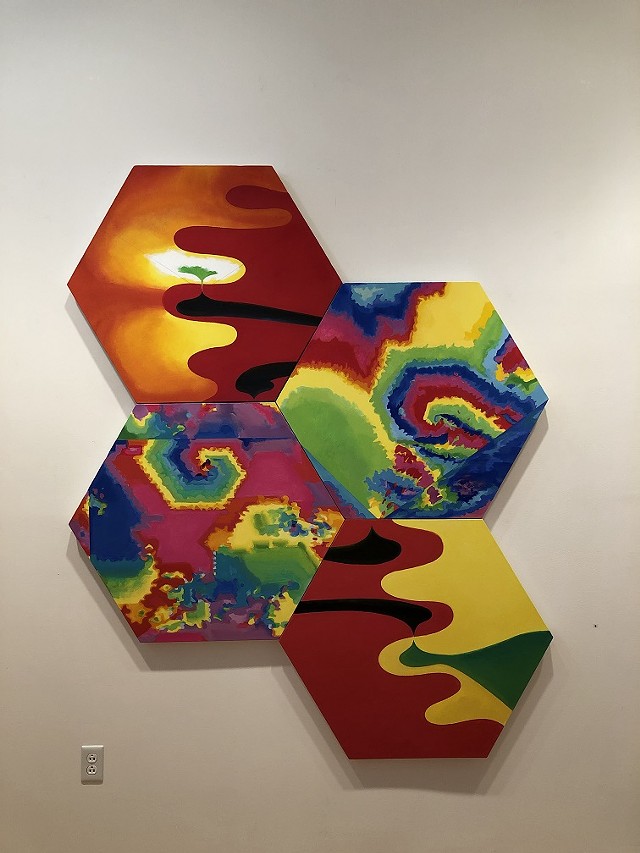
- PHOTO BY REBECCA RAFFERTY
- "New Neighbhorhood," an oil painting installation by Alan Singer.
Though they're two-dimensional, many of Singer's monotype prints contain such a sense of depth, it seems like you could walk into the plane and explore that world in three dimensions. Singer makes images heavy with shapes and bright, bold spectrums of curved light, creating highly abstracted playgrounds onto which a viewer can project their own associations. The dreamy, appropriately-titled 2016 work "Enigma" features a dark almost-sphere, balanced by a glowing yellow dome and surrounded by flowing lines of bright and dusky curves. The scene brings to my mind a cliff and waterway at sunset, with some inscrutable dark body floating on the water. It seems like a liminal, intangible space, ruled by some unfathomable presence.
Many other pieces similarly straddle metaphysical and tangible realms. The subdued glory-shape in the 2018 monotype "Tacit Knowledge" is pushed and pulled by bursts of primary colors, and reads like a private epiphany made visible. The Art Deco-esque "Importance of Light" is dominated by an absinthe-green sphere floating over the junction of a dark rift, and has an undeniable feeling of reverence to it. "Tropicalia" has no solid forms in it, but its shapes and hot hues speak of sunlight and fronds of equatorial flora.
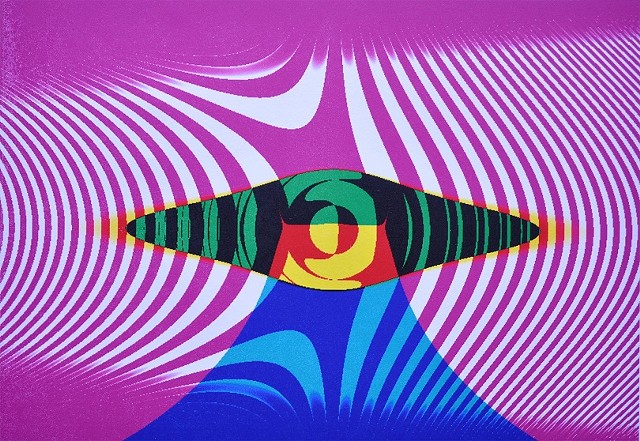
- PHOTO PROVIDED
- Alan Singer's monotype "Modern Dance."
In other works, the shapes take on more concrete personalities and are staged in slightly more defined, dimensional environments. For example, in the monotype print "Pose Please" figurative elements shaped like knotted tubes interact, the cheeky title insinuating that one is photographing the other.
There's a sneaky balance between what can be read as narratives or reductive, pure phenomena in the various pieces, and many of the works feel almost cosmic in nature. The ribbons of light pouring forth from a central vanishing point in Singer's 2017 work "Spinner" bring to mind a scene in the film, "2001: A Space Odyssey," in which the protagonist Dave is traveling through the wormhole.
But Singer hasn't forsaken analog methods of creating art -- he says he still revels in the tangible materials and the emotional connection of the human hand in art. He often creates oil, acrylic, or pastel paintings based on his code-based renderings. Curves of light and primary colors dance on the oblong panels in "Five Spot," an installation of oil paintings that bring to mind the colorful tricks of reflected light on the surfaces of floating soap bubbles. Another oil-on-oval-panel, "Inside Outside" is a painstakingly-painted series of bright, curved lines, dizzyingly arching into a vanishing point.
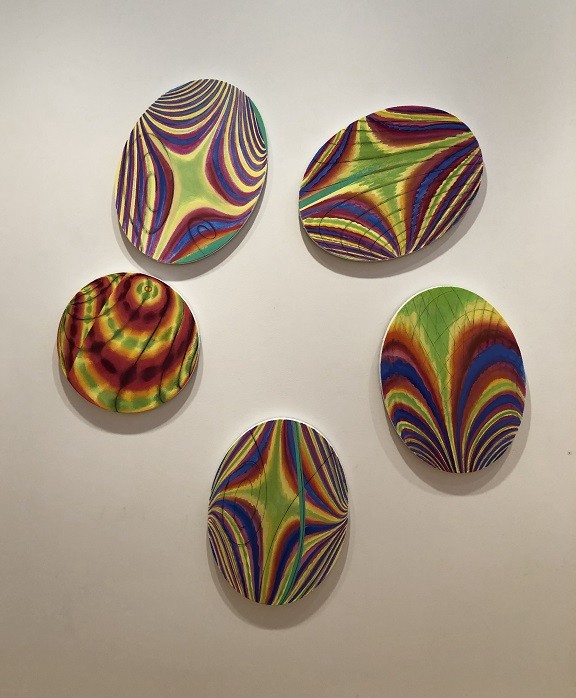
- PHOTO BY REBECCA RAFFERTY
- Alan Singer's oil painting installation "Five Spot."
One of the largest works in the show, the two-panel, acrylic painting "Night Crown" seems to be titled for the subtle dark blue ring painted over the buzzing, shifting geometric pattern that straddles the panels. Built of four converging hexagonal panels, the oil painting "New Neighborhood" shifts between waves hot wavelengths of light, and pixelated fractals spiraling infinitely inward.
Just like a photographer in the darkroom working to document which methods create what outcomes, Singer takes extensive notes to document the results of his experimental use of code. He's got many books full of these notes, and says he might publish them in the future.
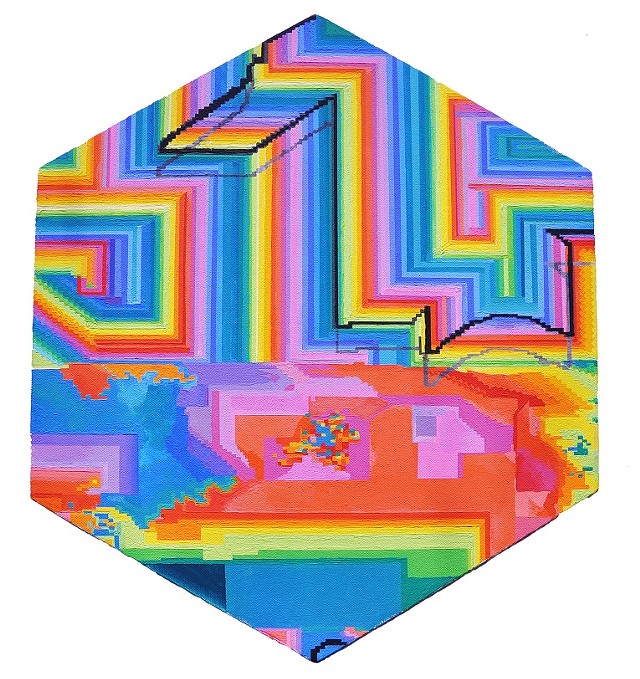
- PHOTO PROVIDED
- "Electrical Storm, New York," an acrylic and gouache painting by Alan Singer.